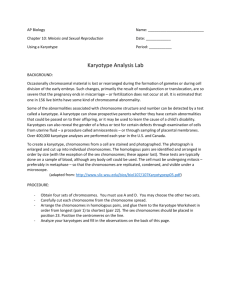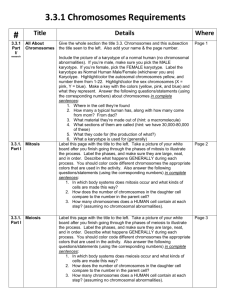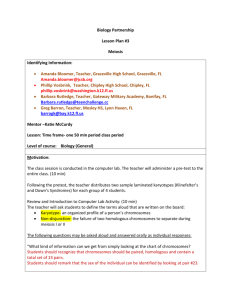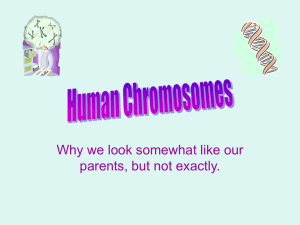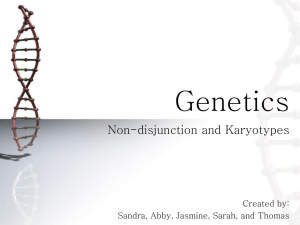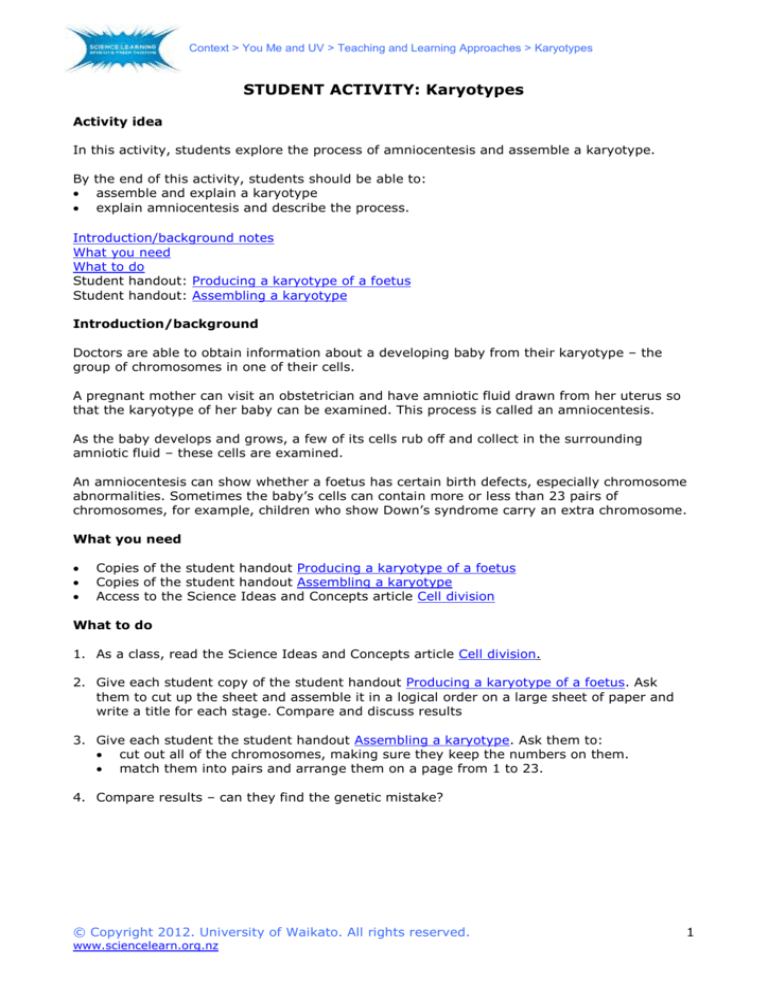
Context > You Me and UV > Teaching and Learning Approaches > Karyotypes
STUDENT ACTIVITY: Karyotypes
Activity idea
In this activity, students explore the process of amniocentesis and assemble a karyotype.
By the end of this activity, students should be able to:
assemble and explain a karyotype
explain amniocentesis and describe the process.
Introduction/background notes
What you need
What to do
Student handout: Producing a karyotype of a foetus
Student handout: Assembling a karyotype
Introduction/background
Doctors are able to obtain information about a developing baby from their karyotype – the
group of chromosomes in one of their cells.
A pregnant mother can visit an obstetrician and have amniotic fluid drawn from her uterus so
that the karyotype of her baby can be examined. This process is called an amniocentesis.
As the baby develops and grows, a few of its cells rub off and collect in the surrounding
amniotic fluid – these cells are examined.
An amniocentesis can show whether a foetus has certain birth defects, especially chromosome
abnormalities. Sometimes the baby’s cells can contain more or less than 23 pairs of
chromosomes, for example, children who show Down’s syndrome carry an extra chromosome.
What you need
Copies of the student handout Producing a karyotype of a foetus
Copies of the student handout Assembling a karyotype
Access to the Science Ideas and Concepts article Cell division
What to do
1. As a class, read the Science Ideas and Concepts article Cell division.
2. Give each student copy of the student handout Producing a karyotype of a foetus. Ask
them to cut up the sheet and assemble it in a logical order on a large sheet of paper and
write a title for each stage. Compare and discuss results
3. Give each student the student handout Assembling a karyotype. Ask them to:
cut out all of the chromosomes, making sure they keep the numbers on them.
match them into pairs and arrange them on a page from 1 to 23.
4. Compare results – can they find the genetic mistake?
© Copyright 2012. University of Waikato. All rights reserved.
www.sciencelearn.org.nz
1
Context > You Me and UV > Teaching and Learning Approaches > Karyotypes
Student handout: Producing a karyotype of a foetus
A stain is added that will stain different parts
of the chromosome different shades.
Once the fluid is at the lab, it is split into a
number of tubes (possibly 15). This will
ensure results are accurate as repeat tests
can be made.
The cells are allowed to multiply, and then at
one stage in the cell division cycle, they are
made to stop dividing. This point is the best
for observing chromosomes.
Water is placed in with the chromosomes.
This causes them to swell so they are easier
to see.
A picture is taken of the chromosomes, and
it is enlarged so the scientist can see the
chromosomes properly.
Pairs of chromosomes are stained the same
and are the same length with the
centromere at the same place, so the
scientists can arrange the chromosomes into
a karyotype – an arrangement of
chromosomes according to size order.
The needle goes through the muscles of the
abdomen and the muscles of the uterus into
the amniotic fluid. The baby has done a lot
of moving and growing, so its cells are in the
fluid and so is a lot of its urine. The doctor
collects about 20 ml of amniotic fluid so they
can extract some cells to look for
chromosomes. (The pain the mother feels is
no more than an injection from a dentist.)
The mother-to-be visits a specialist
obstetrician. This doctor will use ultrasound
to see where the baby is in the amniotic fluid
as they do not want the needle to go near
the baby. The doctor will observe a monitor
throughout the amniocentesis to check for
the position of the baby.
© Copyright 2012. University of Waikato. All rights reserved.
www.sciencelearn.org.nz
2
Context > You Me and UV > Teaching and Learning Approaches > Karyotypes
Student handout: Assembling a karyotype
© Copyright 2012. University of Waikato. All rights reserved.
www.sciencelearn.org.nz
3


